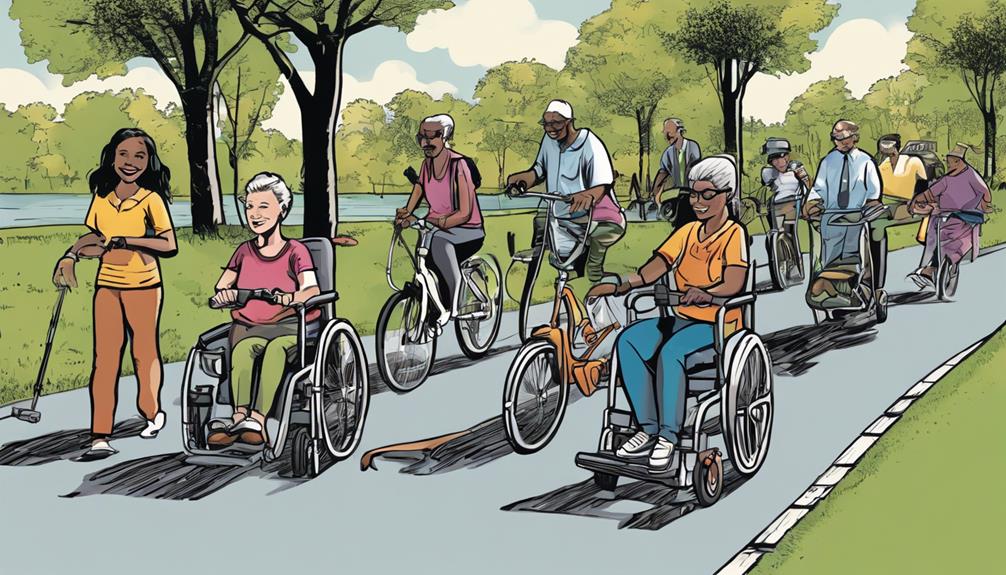Embrace the 5 core principles of design thinking! Prioritize user needs with empathy and user-centricity. Foster collaboration through ideation for innovative solutions. Drive progress with experimentation and iteration, refining ideas based on feedback. Emphasize a bias towards action, pushing for tangible results without overthinking. Engage in hands-on problem-solving, involving stakeholders to create practical solutions. Access the power of design thinking for user-friendly outcomes and drive innovation.
Key Takeaways
- User-Centricity: Understanding user needs at a fundamental level.
- Collaboration: Effective cooperation and open communication in ideation.
- Experimentation: Prototyping, testing, and iterative changes based on user feedback.
- Bias Towards Action: Encouraging tangible implementation and continuous experimentation.
- Hands-On Problem-Solving: Stakeholder involvement, user feedback, and tangible solutions drive innovation.
User-Centricity and Empathy
Design thinking emphasizes user-centricity and empathy to create products that deeply resonate with users on an emotional level. By focusing on user needs and understanding people at a fundamental level, design thinking guarantees that the final product addresses real user problems and adds genuine value to their lives.
User empathy, a core principle of design thinking, guides the development process towards creating solutions that truly connect with users on an emotional level. Techniques like user interviews, surveys, and observation play an essential role in gathering insights and understanding user experiences.
This user-centric design approach leads to more successful and user-friendly product outcomes, as it's rooted in empathy and a profound understanding of human needs. By prioritizing user empathy and centering the design process around real users, design thinking nurtures a culture of creating products that not only meet user expectations but also resonate deeply with their emotions.
Collaboration and Ideation

Effective cooperation among team members, stakeholders, and end users is vital in fostering creative problem-solving within the design thinking process. Cooperation involves gathering diverse perspectives to generate innovative solutions.
In the ideation phase, brainstorming sessions are essential for exploring multiple ideas and challenging assumptions. Through open communication and constructive feedback, team members can refine concepts and push boundaries to develop user-centric solutions.
Ideation encourages thinking creatively and embracing a culture of innovation. By fostering a cooperative environment that values input from all stakeholders, teams can explore unconventional approaches to problem-solving. This approach not only leads to the creation of innovative solutions but also secures that the end products are tailored to meet the needs of the users effectively.
Experimentation and Iteration

Continuous improvement of ideas through prototyping and testing is a key aspect of experimentation and iteration in design thinking. Designers engage in a structured process where they create small-scale prototypes to gather feedback and insights for enhancement.
To secure the experiments are focused, designers establish clear goals, hypotheses, and key performance indicators (KPIs) upfront. By testing these prototypes and collecting user feedback, designers can drive iterative changes to enhance the final product or solution.
The iterative process based on feedback guarantees that the end product aligns with user needs and expectations, leading to a more user-centric design. Through this methodical approach, designers can validate assumptions, refine concepts, and ultimately deliver solutions that are both effective and impactful.
Bias Towards Action

Emphasizing the importance of proactive steps in problem-solving and impact creation, bias towards action in design thinking encourages tangible implementation over analysis paralysis. This principle drives the iterative nature of design thinking, pushing for continuous experimentation and practical application of ideas.
Instead of getting bogged down in endless planning, design thinking advocates for rapid prototyping and testing to gather feedback and refine solutions effectively. By favoring tangible steps and a user-centric problem-solving approach, design thinking fosters a culture of innovation and adaptability within teams.
Implementing ideas swiftly and engaging in continuous experimentation are key aspects of bias towards action. This proactive stance not only accelerates the problem-solving process but also allows for quick adjustments based on real-world feedback. By adopting a bias towards action, teams can break free from stagnant processes and embrace a dynamic environment where refining solutions is a natural part of the journey towards impactful outcomes.
Hands-On Problem-Solving

A hands-on approach in design thinking prioritizes action and tangible solutions to actively engage stakeholders in problem-solving processes. This methodology encourages active participation in all stages, from ideation to prototyping, testing, and iteration.
By involving stakeholders in creating real-world solutions, design thinking guarantees that ideas are refined based on user interactions and feedback. This hands-on problem-solving approach emphasizes the importance of experimentation and continuous learning to drive innovation in product development.
Through this process, ideas aren't just conceptualized but implemented, tested, and improved upon to make a meaningful impact. Design thinking fosters a culture where tangible solutions are created collaboratively, and where stakeholders play an essential role in shaping the final outcome.
Frequently Asked Questions
What Are the Five Principles of Design Thinking?
To understand the five principles of design thinking, focus on user-centricity, collaboration, ideation, experimentation, and iteration. These principles drive creativity and problem-solving by prioritizing user needs, diverse perspectives, idea generation, testing, and continuous improvement.
What Are the 5 Points of Design Thinking?
You want to know the 5 points of design thinking? Well, get ready for a ride! User-centricity, collaboration, ideation, experimentation, and bias towards action are the core principles that drive innovative solutions. Ready to immerse yourself?
What Are the Five Phases of Design Thinking?
To understand design thinking, first grasp its five phases: Empathize, Define, Ideate, Prototype, and Test. Each step is essential for user understanding, problem-solving, idea generation, solution creation, and validation. Master these phases for success.
Who Created the 5 Stages of Design Thinking?
You might be surprised to know that the 5 stages of Design Thinking were created by the Stanford d.school. They crafted these stages to guide problem-solving in a user-centric way, emphasizing empathy and innovation.
Conclusion
To sum up, the 5 core principles of design thinking provide a powerful framework for tackling complex problems.
By prioritizing:
- User-Centricity and Empathy,
- Collaboration and Ideation,
- Experimentation and Iteration,
- Bias Towards Action, and
- Hands-On Problem-Solving,
you can create innovative solutions that truly make a difference.
Remember to embrace these principles in your design process to drive creativity and success!









